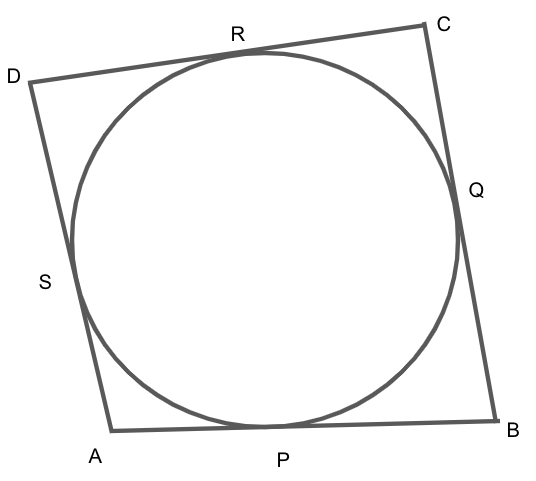
A quadrilateral ABCD is drawn to circumscribe a circle (see Figure). Prove that \[{\text{AB}} + {\text{CD}} = {\text{AD}} + {\text{BC}}\].


Answer
573.9k+ views
Hint: First, we will use the tangents drawn from an exterior point to a circle are equal in length and then add the obtained equations. Then we will use the \[AP + BP = AB\], \[BQ + CQ = BC\], \[CR + DR = CD\] and \[AS + DS = AD\] to simplify this expression.
Complete step by step answer:
We are given that a quadrilateral ABCD is drawn to circumscribe a circle.
We know that tangents drawn from an exterior point to a circle are equal in length, so we have
\[ \Rightarrow AP = AS{\text{ ......eq.(1)}}\]
\[ \Rightarrow BP = BQ{\text{ ......eq.(2)}}\]
\[ \Rightarrow CR = CQ{\text{ ......eq.(3)}}\]
\[ \Rightarrow DR = DS{\text{ ......eq.(4)}}\]

Adding the equations (1), (2), (3) and (4), we get
\[ \Rightarrow AP + BP + CR + DR = AS + BQ + CQ + DS\]
Rewriting the above equation, we get
\[ \Rightarrow \left( {AP + BP} \right) + \left( {CR + DR} \right) = \left( {AS + DS} \right) + \left( {BQ + CQ} \right){\text{ .......eq.(5)}}\]
Since we also know that AB is a line segments and when any point P cuts this line segments, then \[AP + BP = AB\].
From the same procedure, we get
\[BQ + CQ = BC\]
\[CR + DR = CD\]
\[AS + DS = AD\]
Using these sums from the given diagram in the equation (5), we get
\[ \Rightarrow AB + CD = AD + BC\]
Hence, proved.
Note: In this question, we know that circumscribes a circle is to draw on the outside of just touching the corner points but never crossing. Here a quadrilateral is circumscribed around a circle. Students must crack the point of using that tangents drawn from an exterior point to a circle are equal in length. If we are able to crack this point, then the proof is very simple.
Complete step by step answer:
We are given that a quadrilateral ABCD is drawn to circumscribe a circle.
We know that tangents drawn from an exterior point to a circle are equal in length, so we have
\[ \Rightarrow AP = AS{\text{ ......eq.(1)}}\]
\[ \Rightarrow BP = BQ{\text{ ......eq.(2)}}\]
\[ \Rightarrow CR = CQ{\text{ ......eq.(3)}}\]
\[ \Rightarrow DR = DS{\text{ ......eq.(4)}}\]

Adding the equations (1), (2), (3) and (4), we get
\[ \Rightarrow AP + BP + CR + DR = AS + BQ + CQ + DS\]
Rewriting the above equation, we get
\[ \Rightarrow \left( {AP + BP} \right) + \left( {CR + DR} \right) = \left( {AS + DS} \right) + \left( {BQ + CQ} \right){\text{ .......eq.(5)}}\]
Since we also know that AB is a line segments and when any point P cuts this line segments, then \[AP + BP = AB\].
From the same procedure, we get
\[BQ + CQ = BC\]
\[CR + DR = CD\]
\[AS + DS = AD\]
Using these sums from the given diagram in the equation (5), we get
\[ \Rightarrow AB + CD = AD + BC\]
Hence, proved.
Note: In this question, we know that circumscribes a circle is to draw on the outside of just touching the corner points but never crossing. Here a quadrilateral is circumscribed around a circle. Students must crack the point of using that tangents drawn from an exterior point to a circle are equal in length. If we are able to crack this point, then the proof is very simple.
Recently Updated Pages
Master Class 9 Social Science: Engaging Questions & Answers for Success

Master Class 9 Science: Engaging Questions & Answers for Success

Master Class 9 English: Engaging Questions & Answers for Success

Master Class 9 Maths: Engaging Questions & Answers for Success

Master Class 9 General Knowledge: Engaging Questions & Answers for Success

Class 9 Question and Answer - Your Ultimate Solutions Guide

Trending doubts
Which places in India experience sunrise first and class 9 social science CBSE

Fill the blanks with the suitable prepositions 1 The class 9 english CBSE

Write the 6 fundamental rights of India and explain in detail

Difference Between Plant Cell and Animal Cell

What is the Full Form of ISI and RAW

What is pollution? How many types of pollution? Define it




